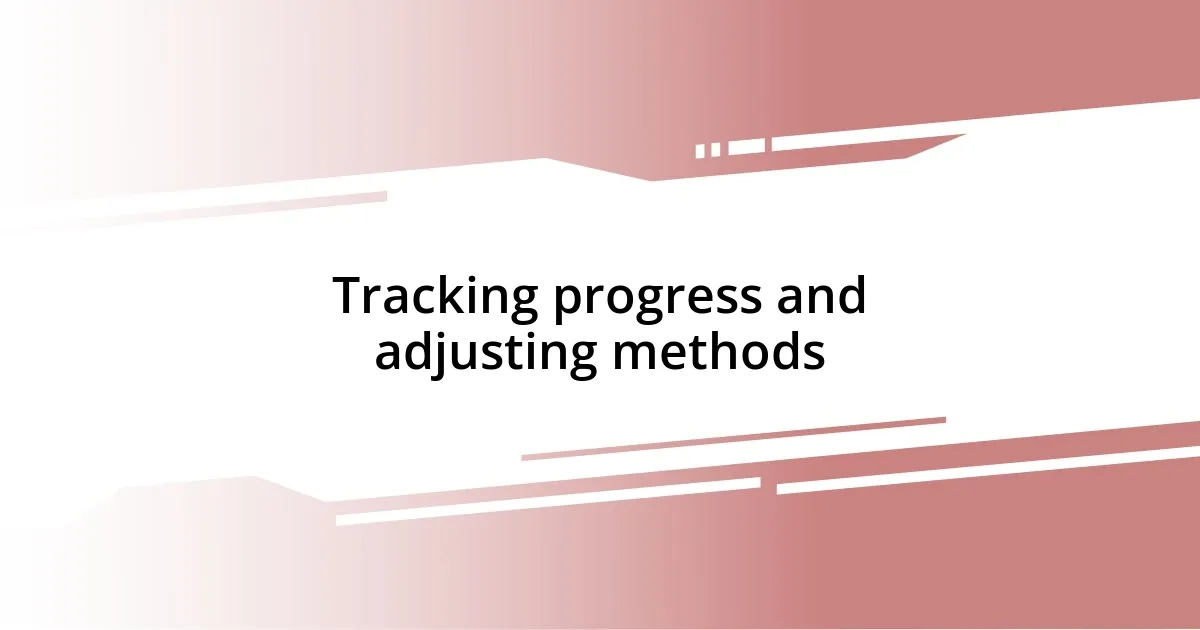Key takeaways:
- Pronunciation challenges stem from differences in sounds between native and target languages; embracing mistakes is part of the learning process.
- Setting specific, measurable pronunciation goals and seeking feedback from native speakers can significantly enhance pronunciation skills.
- Utilizing various effective resources, such as apps and online courses, alongside daily practice techniques like shadowing and tongue twisters, aids in improving pronunciation.
- Tracking progress through recordings and adjusting methods, such as incorporating singing, helps maintain motivation and highlights growth in pronunciation abilities.

Understanding pronunciation challenges
When I first started learning a new language, the struggle with pronunciation was real. I remember feeling frustrated every time I mispronounced a word that seemed so simple in theory but became a tongue twister in practice. Have you ever found yourself in a similar situation, trying to sound like a native speaker but ending up with puzzled looks instead?
One significant challenge is the difference between the sounds we’re used to in our native language and those in a new one. For instance, I found it difficult to distinguish between sounds like /θ/ in “think” and /s/ in “sink” – they felt worlds apart, yet my tongue insisted on creating the same familiar shape. This gap can be daunting; it’s as if you’re speaking a completely different language—not just in vocabulary, but even in sound.
I often remind myself that everyone faces these hurdles, and it’s okay to stumble. There was a moment when I mispronounced a crucial word during a presentation and felt my cheeks flush with embarrassment. But my audience appreciated my effort, and that comforting thought kept me going. How do we shift our mindset to embrace mistakes as part of the learning process? Sometimes, it just takes a little humor and a lot of practice to break through those barriers.

Setting specific pronunciation goals
Setting specific pronunciation goals is essential for making real progress. I remember setting a goal to master the /r/ and /l/ sounds in English. It wasn’t just a whim; I recorded myself and compared my pronunciation to native speakers, which helped me identify clear targets. Focusing on one or two sounds at a time allowed me to track my improvement more effectively.
Here are some practical tips for setting your pronunciation goals:
- Identify Specific Sounds: Choose the sounds that challenge you the most. Perhaps it’s the difference between /v/ and /w/, or /i/ in “beet” versus /ɪ/ in “bit.”
- Use Measurable Outcomes: Set achievable targets, such as being able to pronounce five difficult words correctly in a conversation.
- Create a Schedule: Dedicate specific times each week to practice these sounds using focused exercises.
- Record Progress: Regularly record your practice sessions. Listening to earlier recordings can be both eye-opening and motivating.
- Seek Feedback: Share your recordings with native speakers or language partners. Their insights can provide encouragement and direction.
I found that these steps not only helped me improve my pronunciation but also boosted my confidence in speaking. Each small victory felt like a milestone, reminding me that with patience and persistence, I could achieve my goals.

Choosing effective practice resources
Choosing effective practice resources can significantly impact your pronunciation journey. When I was refining my pronunciation, I experimented with various tools, such as language apps, online courses, and YouTube videos. Each resource had its unique advantages; for instance, apps provided instant feedback, while videos allowed me to hear the nuances of native speakers. It’s essential to find what resonates most with you and suits your learning style.
I recall the first time I used a pronunciation app. At first, I was skeptical, but as I repeated the exercises, I felt more connected to the sounds. Engaging with interactive features, like mimicking native pronunciation and receiving immediate feedback, made the practice more enjoyable. Have you found a resource that transforms your learning experience? The right tools can truly motivate you and foster your growth.
To give you a clearer picture, I’ve outlined a comparison of some popular resources. This table highlights their core features and suitability for various learning styles:
| Resource | Features |
|---|---|
| Pronunciation Apps | Interactive exercises, instant feedback, sound comparisons |
| YouTube Tutorials | Visual learning, native accents, diverse topics |
| Language Exchange Platforms | Real-world practice, cultural insights, personalized feedback |

Techniques for daily pronunciation practice
Practicing pronunciation daily can be both rewarding and fun! One technique that I swear by is shadowing, where you listen to a native speaker and simultaneously repeat what they say. This method not only helps improve my rhythm and intonation but also allows me to mimic their mouth movements, which I find incredibly valuable. Have you ever tried this way of practicing? It feels like dancing to the music of language!
Another technique that’s made a significant difference in my practice is using tongue twisters. I remember stumbling over phrases like “She sells seashells by the seashore” at first, but with regular repetition, I noticed my muscle memory sharpen. It’s almost like giving my mouth a workout! Plus, tackling tongue twisters always brings a smile to my face when I finally nail them, transforming a challenging task into a fun game.
Finally, I’ve discovered that engaging in conversation with language partners is one of the best approaches for practical pronunciation practice. The moment I started speaking with native speakers, I felt an added layer of pressure—and excitement—to pronounce words correctly. It’s in those real-life situations that I truly learned to adapt and improve. Have you ever felt that rush? Knowing you’re communicating with someone from a different culture adds a unique thrill to the experience, making every pronunciation correction a stepping stone toward mastery.

Utilizing recordings for feedback
Utilizing recordings for feedback has been a game-changer for me in refining my pronunciation. In my early days of language learning, I would record my sentences, then listen back to see where I stumbled. Let me tell you, it was eye-opening! Hearing my own voice helped me identify patterns in my speech that I hadn’t noticed before. Has that ever happened to you?
When I listen to recorded feedback, I often find myself surprised by how I sound compared to native speakers. It’s like looking into a mirror for my voice. One time, during a practice session, I recorded myself reading an excerpt from a book in Spanish. Listening to it afterward, I realized my vowel sounds were far off from what I intended. That realization sparked a focused effort to improve, and over time, I could hear the difference in my recordings—what a satisfying feeling!
Sharing my recordings with friends who are fluent has also provided invaluable insights. Their feedback pointed out nuances I’d never considered, like the importance of stress on certain syllables. How could I have overlooked that? Plus, it’s always encouraging to see the progress over time, from hesitant stumbles to more confident delivery. This practice not only hones my pronunciation; it nurtures a deeper connection with the language itself.

Incorporating language immersion strategies
Incorporating language immersion strategies has truly transformed my pronunciation journey. One of the most impactful experiences was when I decided to surround myself with the language—whether through watching movies or listening to music. I vividly recall one evening, binge-watching a popular series in French. The moment I turned off the subtitles, I was amazed at how much I picked up, not only in vocabulary but also in the way native speakers articulated their words. Have you ever felt that rush of understanding that comes from being completely immersed?
I find that setting up a language-rich environment can unleash a creativity I never knew I had. Decorating my space with posters of common phrases or labeling items in my house with their names in the target language helped me reinforce what I was learning. I remember sticking labels on everything from my coffee mug to the fridge—turns out, even my morning routine became a pronunciation practice session without me realizing it! Who knew that simulating a home environment could make learning so engaging?
Diving into conversations with locals during my travels has also proven invaluable. When I visited a small town in Spain, I felt the anxiety bubbling up as I attempted to order food in Spanish. To my surprise, the locals were welcoming and encouraged my attempts, laughing off any mistakes. It reminded me that pronunciation is a journey, and it’s okay to stumble along the way. Have you found that real-world interactions make your practice feel more genuine?

Tracking progress and adjusting methods
Tracking my progress in pronunciation has been essential for my growth as a language learner. I remember a period where I kept a simple journal, documenting specific sounds I struggled with each week. Looking back at those entries, I could see patterns—like how I consistently mixed up certain consonant pairs. This awareness drove me to focus my practice more strategically and it’s gratifying to see documented improvement.
Adjusting methods as I track my progress has also played a significant role. For instance, after noticing that I was still struggling with intonation, I switched from just speaking aloud to incorporating singing—yes, singing! I tried karaoke in my target language and discovered that singing helped me play with pitch and flow in a way traditional practice never did. Have you ever felt how music can transform your connection to language? Those sessions were full of laughter, yet I found myself resonating with the sounds far more effectively than before.
I’ve found that regular check-ins with myself are beneficial. I review recordings from a month ago and contrast them with my current sessions; the difference can be astounding! One time, I listened to an old clip where my pronunciation was shaky and compared it to my latest recording, where I confidently pronounced complex phrases. That stark contrast always motivates me. How do you measure your improvements? For me, that tangible evidence of growth keeps the excitement alive in my learning journey.













